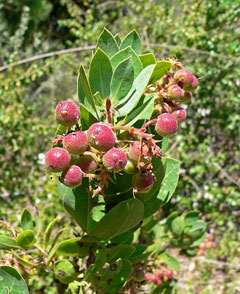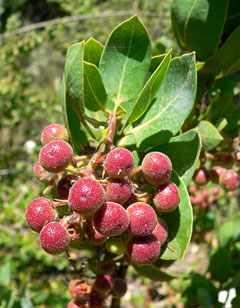 |
|
http://commons.wikimedia.org/wiki/User:Stan_Shebs |
 |
| http://commons.wikimedia.org/wiki/User:Stan_Shebs |
Translate this page:
Summary
Physical Characteristics

 Arctostaphylos glauca is an evergreen Shrub growing to 4 m (13ft 1in).
Arctostaphylos glauca is an evergreen Shrub growing to 4 m (13ft 1in).
See above for USDA hardiness. It is hardy to UK zone 8. It is in leaf all year, in flower from April to May. The species is hermaphrodite (has both male and female organs) and is pollinated by Bees. The plant is self-fertile.
Suitable for: light (sandy) and medium (loamy) soils and prefers well-drained soil. Suitable pH: mildly acid soils and can grow in very acid soils.
It can grow in semi-shade (light woodland) or no shade. It prefers dry or moist soil.
UK Hardiness Map
US Hardiness Map
Synonyms
Plant Habitats
Woodland Garden Sunny Edge;
Edible Uses
Edible Parts: Fruit
Edible Uses: Drink
Fruit - raw or cooked[3]. The fruit is used fresh or it can be dried and ground into a powder then used to make mush or added to soups etc[105, 161, 183, 257]. It can also be used to make preserves or a beverage that resembles cider in flavour[183]. A drink is made from the berries by sprinkling them with water, kneading them with the hands, mashing them and then soaking them in the sun for about 12 hours. The liquid is then sieved to remove the pulp before being drunk on its own or with Chia (see Salvia columbiana). Water could be drained through the pulp a second time. The liquid was said to be sweet and fattening[257]. The fruit is dry and with little flavour[2]. The seeds can be dried, ground into a powder and used to make a mush or cakes[257]. The seed is rather small, it would most probably have been used together with the fruit and not have been separated from it[K].
References More on Edible Uses
Medicinal Uses
Plants For A Future can not take any responsibility for any adverse effects from the use of plants. Always seek advice from a professional before using a plant medicinally.
Antiseptic Astringent Diuretic Skin Urinary
The dried leaves are used in the treatment of a variety of complaints[4]. These leaves should be harvested in early autumn, only green leaves being selected, and then dried in gentle heat[4]. A tea made from the dried leaves is strongly astringent, diuretic and an antiseptic for the urinary tract[4, 222]. It is much used for kidney and bladder complaints and inflammation of the urinary tract, but it should be used with caution[4, 21, 46, 172] because it contains arbutin which hydrolyzes into the toxic urinary antiseptic hydroquinone[222]. Externally, an infusion is used to treat poison oak rash[257].
References More on Medicinal Uses
The Bookshop: Edible Plant Books
Our Latest books on Perennial Plants For Food Forests and Permaculture Gardens in paperback or digital formats.

Edible Tropical Plants
Food Forest Plants for Hotter Conditions: 250+ Plants For Tropical Food Forests & Permaculture Gardens.
More

Edible Temperate Plants
Plants for Your Food Forest: 500 Plants for Temperate Food Forests & Permaculture Gardens.
More

More Books
PFAF have eight books available in paperback and digital formats. Browse the shop for more information.
Shop Now
Other Uses
Broom Dye Fuel Wood
A yellowish-brown dye is obtained from the leaves, it does not require a mordant[168]. The branches have been used to make a broom[257]. The wood makes a good fuel, producing a lot of heat and burning for a long time[257]. The wood is hard and tough. It is used for making small tools, awl handles etc[257].
Special Uses
References More on Other Uses
Cultivation details
Requires a deep moist well-drained light or medium lime-free loam in sun or semi-shade[3, 11, 200] but plants produces less fruit when they are grown in the shade[200]. Prefers a warm sunny position[3, 166]. Found on dry soils in the wild, one report says that it succeeds in a hot dry position. Hardy to between -5 and -10°c, succeeding outdoors in the milder parts of Britain[200]. Plants resent root disturbance and should be placed in their final positions as soon as possible[134].
References Carbon Farming Information and Carbon Sequestration Information
Temperature Converter
Type a value in the Celsius field to convert the value to Fahrenheit:
Fahrenheit:
The PFAF Bookshop
Plants For A Future have a number of books available in paperback and digital form. Book titles include Edible Plants, Edible Perennials, Edible Trees,Edible Shrubs, Woodland Gardening, and Temperate Food Forest Plants. Our new book is Food Forest Plants For Hotter Conditions (Tropical and Sub-Tropical).
Shop Now
Plant Propagation
Seed - best sown in a greenhouse as soon as it is ripe. Pre-soak dried seed in boiling water for 10 - 20 seconds or burn some straw on top of them and then stratify at 2 - 5°c for 2 months[11, 200]. The seed usually germinates in 2 - 3 months at 15°c[134]. When large enough to handle, prick the seedlings out into individual pots and grow them on in a greenhouse or cold frame for at least their first winter, Plant out in late spring or early summer. Cuttings of side shoots of the current season's growth, 5 - 8cm with a heel, August to December in a frame. Takes one year[1, 78]. Division in early spring. Take care because the plant resents root disturbance. Pot the divisions up and keep them in a lightly shaded position in a cold frame or greenhouse until they are growing away actively. Layering in spring[200].
Other Names
If available other names are mentioned here
Native Range
NORTHERN AMERICA: United States (California), Mexico (Baja California (Norte))
Weed Potential
Right plant wrong place. We are currently updating this section.
Please note that a plant may be invasive in one area but may not in your area so it's worth checking.
Conservation Status
IUCN Red List of Threatened Plants Status :

| Related Plants
|
| Latin Name | Common Name | Habit | Height | Hardiness | Growth | Soil | Shade | Moisture | Edible | Medicinal | Other |
| Arctostaphylos alpina | Alpine Bearberry | Shrub | 0.1 |
-
| | LM | SN | M | 2 | 1 | |
| Arctostaphylos columbiana | Hairy Manzanita | Shrub | 1.5 |
6-9
| | LM | SN | M | 2 | 1 | 2 |
| Arctostaphylos manzanita | Manzanita, Whiteleaf manzanita, Konocti manzanita, Contra Costa manzanita, Roof's manzanita, Wieslan | Shrub | 2.0 |
7-10
| M | LM | SN | DM | 3 | 1 | 3 |
| Arctostaphylos nevadensis | Pine-Mat Manzanita | Shrub | 0.1 |
5-9
| M | LM | SN | M | 2 | 1 | 3 |
| Arctostaphylos parryana | Parry Manzanita | Shrub | 1.8 |
-
| | LM | SN | DM | 1 | 0 | 1 |
| Arctostaphylos patula | Greenleaf Manzanita | Shrub | 2.0 |
5-9
| | LM | SN | M | 3 | 1 | 1 |
| Arctostaphylos pringlei | Stickleaf Manzanita | Shrub | 2.0 |
7-9
| M | LM | N | DM | 3 | 0 | 1 |
| Arctostaphylos pungens | Grayleaf manzanita, Pointleaf Manzanita | Shrub | 2.0 |
7-10
| | LM | SN | DM | 3 | 1 | 2 |
| Arctostaphylos stanfordiana | Stanford's manzanita, Rincon manzanita | Shrub | 1.5 |
5-9
| | LM | SN | DM | 3 | 0 | 1 |
| Arctostaphylos tomentosa | Downy Manzanita, Woollyleaf manzanita, Brittleleaf manzanita, Dacite manzanita, Rosy manzanita, San | Shrub | 1.5 |
7-10
| | LM | SN | M | 3 | 3 | 3 |
| Arctostaphylos uva-ursi | Bearberry, Kinnikinnick | Shrub | 0.1 |
2-8
| M | LM | FSN | M | 3 | 4 | 4 |
| Vaccinium arctostaphylos | Caucasian Whortleberry | Shrub | 3.0 |
5-9
| | LM | SN | M | 3 | 0 | 0 |
|
Growth: S = slow M = medium F = fast. Soil: L = light (sandy) M = medium H = heavy (clay). pH: A = acid N = neutral B = basic (alkaline). Shade: F = full shade S = semi-shade N = no shade. Moisture: D = dry M = Moist We = wet Wa = water.
Now available:
Food Forest Plants for Mediterranean Conditions
350+ Perennial Plants For Mediterranean and Drier Food Forests and Permaculture Gardens.
[Paperback and eBook]
This is the third in Plants For A Future's series of plant guides for food forests tailored to
specific climate zones. Following volumes on temperate and tropical ecosystems, this book focuses
on species suited to Mediterranean conditions—regions with hot, dry summers and cool, wet winters,
often facing the added challenge of climate change.
Read More
Expert comment
Author
Lindl.
Botanical References
1171200
Links / References
For a list of references used on this page please go here
Readers comment
© 2010, Plants For A Future. Plants For A Future is a charitable company limited by guarantee, registered in England and Wales. Charity No. 1057719, Company No. 3204567.